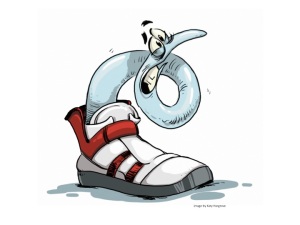 In November 2011, I joined 48 other scientists in a crowdfunding campaign to raise money for science. Thanks to the generosity of family, friends, and interested strangers, my project has been fully funded! Read on to learn about the project and how the funds will be used.
In November 2011, I joined 48 other scientists in a crowdfunding campaign to raise money for science. Thanks to the generosity of family, friends, and interested strangers, my project has been fully funded! Read on to learn about the project and how the funds will be used.In November 2011, athlete’s foot caused 70% of cases of disease in flooded areas of Thailand. The group of fungi that cause athlete’s foot are called the dermatophytes and they are the largest cause of skin infections worldwide. In addition to athlete’s foot, they cause ringworm, scalp infections, jock itch, and nail infections. It is estimated that up to 20% of the worldwide population has a dermatophyte infection right now! (Brief pause while you examine your feet and nails.) Despite the prevalence of these infections and the billions of dollars spent annually to treat them, very little is known about how dermatophytes actually cause disease. One major problem is that we don’t have a very good model to study how these fungi interact with our skin to cause athlete’s foot, ringworm, and other infections.
This project will test a new model to study dermatophyte infections – the worm (nematode) C. elegans. Sound crazy? Actually, there are a surprising number of similarities between C. elegans and your toes! In particular, one of the proteins found in your skin, hair, and nails that dermatophytes love to “eat” is also found in the skin (cuticle) of this little worm. So it might be possible to study how the fungus interacts with the worm and make conclusions about how it is interacting with our skin! Non-mammalian models such as C. elegans are ideal in terms of expense, efficiency, and reducing the number of animals used in research. Funds from this project will provide support for me to train an undergraduate for one month during the summer. Together, we will determine if dermatophytes can cause infections in C. elegans.
This project has two distinct benefits:
1. C. elegans has the potential to be an “elegant” (ha ha, get it?) solution to the problem of studying how dermatophytes cause athlete’s foot, ringworm, and other diseases. This would be a quantitative model that would be cheap and would reduce the number of animals being used for the same purpose.
2. This project allows me to give an undergraduate student some hands-on research experience. This is vital for students who wish to pursue future studies in graduate school and medical/dental schools. It is also increasingly required for students in the sciences who simply wish to find employment after they graduate. Plus, it is a great way for students to find out if they actually like research, as compared to coursework!
Although I teach during the academic year, I am not paid a summer salary. I plan to volunteer my time this summer, and the money raised from crowdfunding will be directed towards:
– lab supplies
– stipend for an undergraduate researcher
– transportation costs
In addition to my funders, I am grateful to Alkali Scientific for the gift of lab consumables. Thanks to their generosity, I am able to put more of my funding towards a stipend for an undergraduate researcher.
